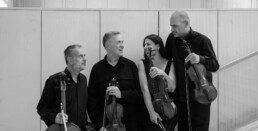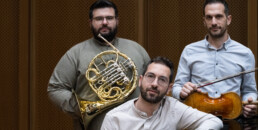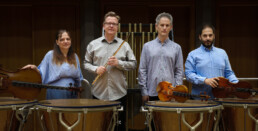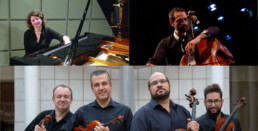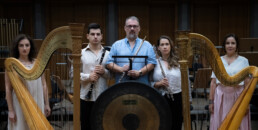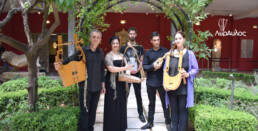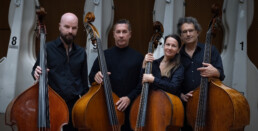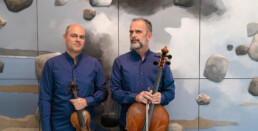Healing Music
The decade of 1820's was undoubtedly an exciting period for the musicophiles of Vienna. Mature and isolated from the rest of the people due to his profound deafness, Ludwig van Beethoven turns almost exclusively to his favorite string quartet, thus creating unprecedentedly complex and beautiful works. His big admirer, Franz Schubert, of assured recognition through his excellent songs, enriches the chamber music repertoire with some of his most important works. In 1824, Schubert composes his quartet No. 13 in A minor to be called "the Rosamunde quartet" due to the melody used in the second movement, taken from the homonymous scenic music. In 1825, Beethoven presented his quartet No. 15, also in A minor, the third movement of which, “Song of Thanksgiving to the Deity from a convalescent in the Lydian mode”, is a sincere confession from the bottom of the great composer's heart, following a serious health problem he had faced.
20 years since the death of Ligeti
On the occasion of his mother's death, Brahms explored the rear sound combination of violin with French horn and piano, composing this trio that now occupies a major position within his rich work for chamber music ensembles. A bit more than a century after, Ligeti, who was very little engaged in small chamber music ensembles, wrote a "Hommage to Brams" Trio, precisely to accompany the German composer's work in concert programmes.
A night in Lilipoupoli
"Children, stick your ears on your radios. There's a surprise for you. Today, the Third Program finally broadcasts Lilipoupoli (the TinyTown)". It is with these words that the radio broadcasting of legendary Lilipoupoli started on Monday, December 19, 1977 at 09:30 AM. Nowadays, Chronos Ensemble, with the addition of Athina Kapsetaki and the collaboration of the soprano Vasia Zacharopoulou and the "12 notes" Children's choir, attempts to remind us the music, as well as some of the most beloved songs then created for a radio program of historical spontaneity, fantasy and boldness, "EDO LILIPOUPOLI"! (Voice of the TinyTown!)
From Austria to a New World
The concert "From Austria to a New World" featuring works for flute and string trio, is a musical journey across countries and centuries. The programme includes renowned works, such as the overture to Mozart's opera "The Magic Flute" transcribed for flute, violin, viola and cello, as well as A. Dvorak's "American" quartet, transcribed for the same ensemble by the famous flutist Emmanuel Pahud. Alongside, less known works are presented, such as Hoffmeister's flute quartet in C minor and the Hungarian composer's Léo Weiner's quartet for flute in C minor.
Aenaon ensemble and friends
The "Aenaon" String Quartet, dynamically present for many years in the domestic chamber music field, collaborates with the double bassist, Nikos Tsoukalas and the pianist Popi Malapani in two major works of late Romanticism: the Czech composer's Antonin Dvorak's String Quintet No. 2 and the English Edward Elgar's Quintet for piano correspondingly.
From Poetry to Music...
The programme follows the paths of inspiration: Debussy is inspired by Bilitiis's erotic poetry (Bilitis is supposed to be a devotee of Sapho), and frames it with emotive, atmospheric soundscapes, while his contemporary composer and classmate, Maurice Emmanuel studies the ancient Greek music and is seduced by the former's innovative attitude. The posterior Japanese composer, Toru Takemitsu draws original material from the Japanese musical tradition, while assimilating Debussy's writing emotiveness, elliptical move and asymmetrical rhythms, as characteristically projected in his work, Rain Spell (1982.
Tribute to Panagiotis Stefos
Panagiotis Stefos is a distinguished trombonist and educator with a notable presence in the Greek music scene. His love for music and his dedication to the trombone have made him one of the most respected and beloved musicians and teachers of his generation, offering his skill and sensitivity in every performance. He is closely associated with Lyraulos, the musical ensemble that revives ancient Greek music and its instruments. With passion and respect for tradition, he contributes significantly to the artistic development of the ensemble and actively participates in its educational and cultural activities. His presence in "Lyraulos" is not merely musical; it is deeply educational and spiritual. With ethos, knowledge, and dedication, he helps bridge the past with the present, illuminating the timeless power of music.
Bass Euphoria
Carte de Tendre:The Map of Tendre (Carte de Tendre or Carte du Tendre) was a French map of an imaginary country named Tendre, created by several hands (including Catherine de Rambouillet). It appeared as an engraving (attributed to François Chauveau) in the first part of Madeleine de Scudéry's 1654-61 novel Clélie. The map represents the path towards love according to the précieuses (cosmopolitan literary and social personalities) of the time period. Inspired by such map, we musically perform the three paths to Tendre through these three suites based on the map.
More than half a quartet
Despite the wide range of the two instruments' mastery and timber, composers had not found a way to express the combination of violin and cello, until the beginning of the 20th century. Few composers had managed to treat the two instruments as equal collaborators and their great peers of the beginning of the 20th century had to broaden their musical dialect, looking for a common ground for the two instruments to harmonically join their pace in large-scale works. Further than their indisputable artistic value, the programme's three works vividly project the rapid developments in the European musical field during the turbulent first quarter of the 20th century.
Corinth's concerto
This year's artistic season concludes with another concert tour outside Athens. Leo Brouwer's Corinth Concerto for guitar, commissioned by the Greek Orchestra of Athens and the Municipality of Corinth, is a wonderful musical "prelude" before the performance of the famous Ninth Symphony by the Czech Romantic Antonín Dvořák, conducted by Nikos Haliasas. This famous symphony was written at the end of the 19th century during the composer's stay in New York, drawing on his musical experiences in the United States and incorporating them into an emotionally charged and orchestrationally brilliant symphonic masterpiece.

